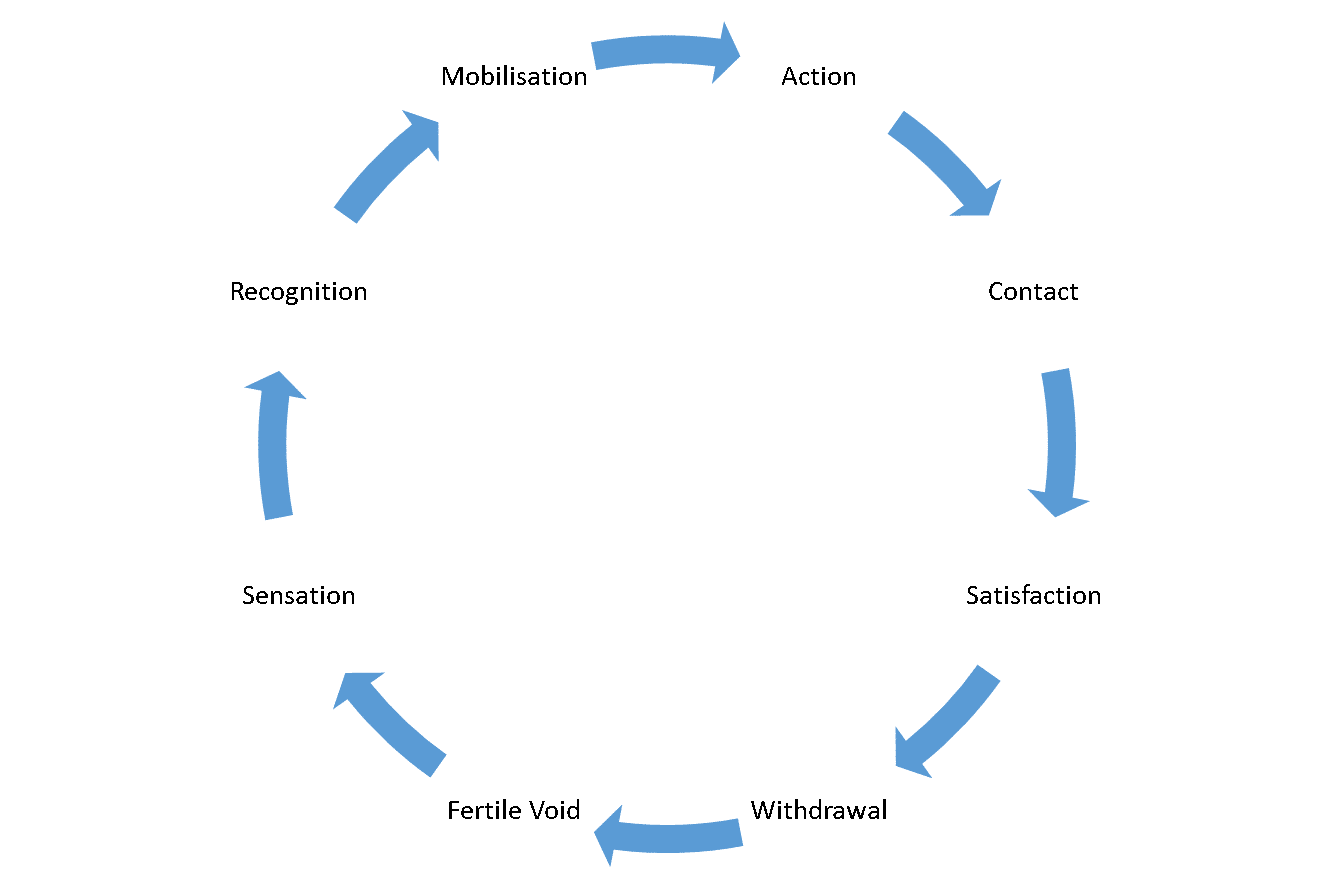Gestalt Cycle & Fixed Gestalts
By Shea Stevens
Gestalt theory is attentive to the importance of getting your needs met, and the impact of having unmet needs. This is central to the concept of the “gestalt cycle.” If you are not familiar with the concept of Organismic Self-Regulation, you can read my post on that, which is deeply tied to this topic.
What is a “gestalt?”
First, what does the german word gestalt mean? A gestalt is a figure that emerges into focus in our perception. Ehrenfels coined the term “Gestalt,” and according to Rosemarie Wulf, it means “a psychical whole formed by the structuring of the perceptual field.” “Our consciousness forms the units of wholes, Gestalten” (Wulf). Kurt Lewin developed the thesis that the need organizes the field; the gestalt formation is based on the needs of the organism.
Gestalt Cycle
Basically, when an organism experiences an imbalance, or tension, it seeks to find relief, to re-establish equilibrium (usually these promptings come from the need for comfort, stimulation, or safety.) Until the organism experiences relief and resolution, there is “unfinished business,” and its gestalt cycle is incomplete. When the organism meets the need, and regains equilibrium, it completes the gestalt cycle. It can then start the cycle again; it can shift its focus. Here is a visual:
Now, the concept of assimilation is a key consideration here; the question of how the organism “digests” the thing. If it is not truly a good match for the organism, or if it an “introject” that is swallowed whole instead of being digested in bite sized pieces, it will give indigestion or bring on the urge to regurgitate. This is “unfinished business” because resolution has not yet been reached.
So, the gestalt cycle is about meeting needs as they arise, one after another, and the goal is to find relief and meet needs in a way that they are assimilated, such that the organism is truly integrating what it takes in, and what is taken in is a good fit for the organism.
What is a fixed gestalt?
A “fixed gestalt” basically means the organism is stuck in one phase of the cycle, it is fixated. This is what happens when a need is not met, when the organism has not reached resolution. This fixed gestalt impacts the organism, its behavior and its experiences, depending on the importance of the uncompleted task, and how long it has gone unmet.
There is a saying that “the need organizes the field;” our present need or unfinished business determines how we make meaning of a situation. It determines what comes into focus and what doesn’t. Unfinished business that is not within a person’s awareness can still wreak havoc, without the person consciously understanding why they are experiencing emotional or mental distress, feeling anger, sadness, worry, exhaustion, or frustration.
As a visual example of a fixed gestalt, you can imagine a tire spinning, trying to get out of a muddy ditch. It is exerting energy but unable to get out of its rut, unable to move to its next task. Ideally one need can be met after another, as each one takes its turn to come into focus (figure) and then slips away into the background (ground).
So when you are unable to get past a task, it takes your focus and energy away from other other tasks, other needs, or other areas of life.
Limitations of this concept
Gestalt theorists encourage us to hold lightly to these theoretical concepts because they all have their limitations. The gestalt cycle and the idea of meeting needs are subject to certain qualifiers: The gestalt cycle visual, pictured above, does not encompass the complexity of all of a person’s simultaneous wants and needs at any given time, which overlap. Some gestalt cycles may be long term, lasting for years, while some are small scale, lasting just a minute. It is a tool for conceptualizing that does not adequately describe the full field, but it can still be useful.
I also want to note that in this post there has not been much attention paid to the question of, ‘what is a want vs a need?’ How does a person decide when it is appropriate to set aside their own wants/needs in order to attend to a greater purpose, or to attend to another person? These are important questions.
References:
Rosemarie Wulf, The Historical Roots of Gestalt Therapy Theory.


